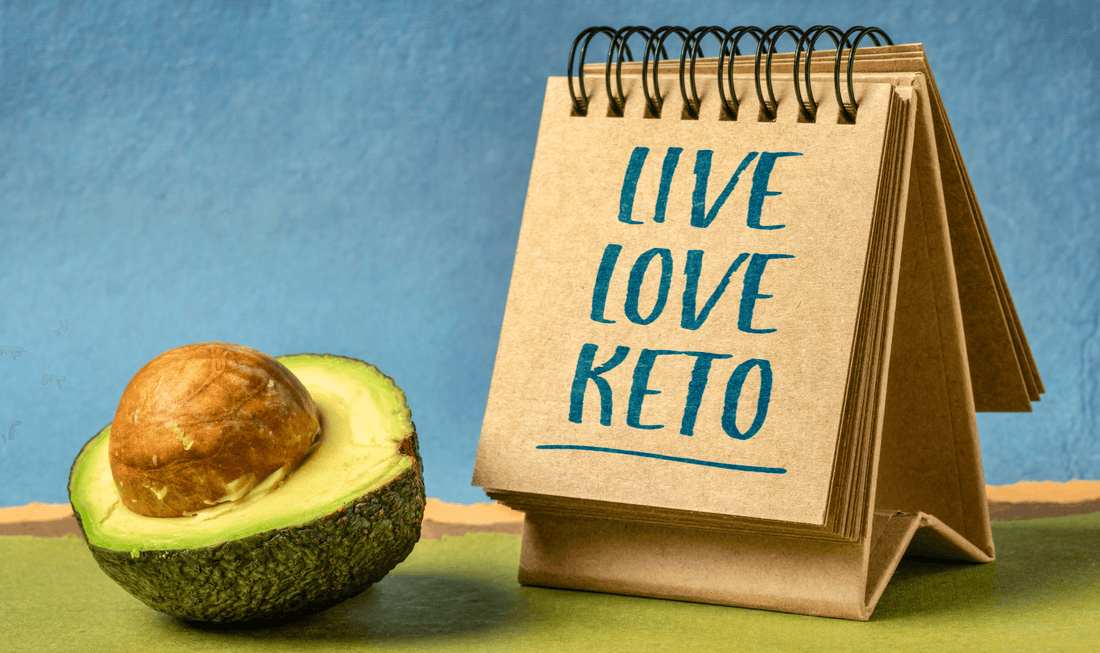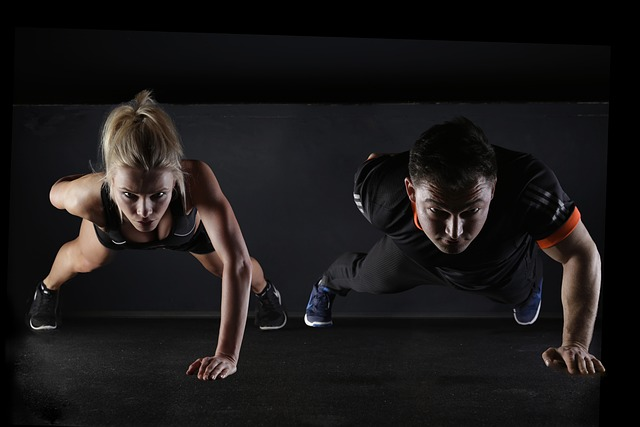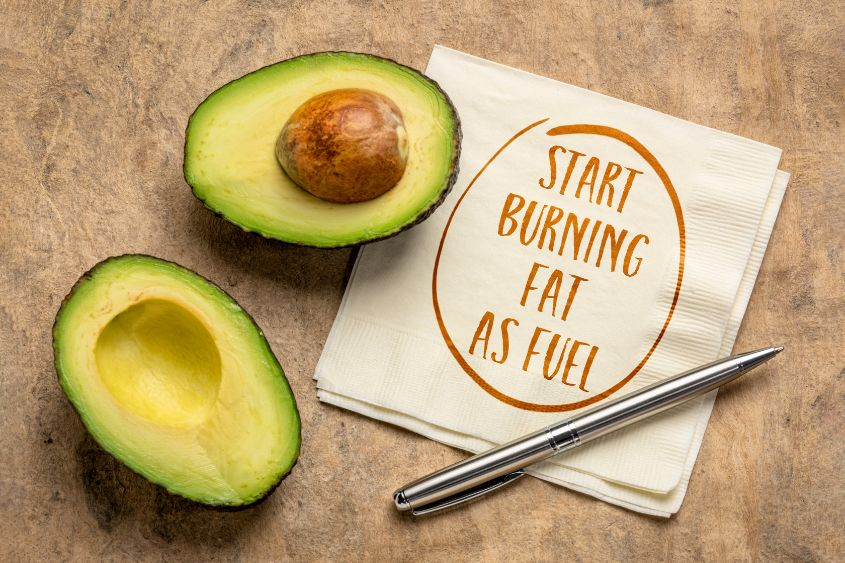Ultimate Weight Loss Guide: Ketogenic Diet, Exercise Pro Tips and Understand TKD and CKD

Welcome to the ultimate weight loss guide that follows the ketogenic diet and provides you with the right kind of exercise to get you in your dream shape! If you've ever embarked on a journey to lose weight, you know that navigating through the sea of information can feel overwhelming. Fads and other diets, conflicting advice, and trendy workout routines can leave you feeling like you're lost in a maze of fitness folklore. But fear not because we're here to help you unlock the secrets of successful weight loss with a powerful combination: the keto diet and exercise.

Picture this: shedding those extra pounds while indulging in delicious, satisfying meals and enjoying energising workouts that leave you feeling stronger and more confident than ever. It may sound like a dream, but the ketogenic diet and exercise can make it a reality. We will debunk myths, share insider tips, and provide you with the essentials to help you lose weight like a champion.
Say goodbye to crash diets that leave you hungry and irritable, and say hello to the wonders of ketosis. The ketogenic diet is not just another passing trend; it's a scientifically-backed approach that harnesses the power of your own body to burn fat as fuel. By drastically reducing your carbohydrate intake and increasing your consumption of healthy fats, you can train your body to enter a state of metabolic bliss. Imagine your body becoming a lean, mean, fat-burning machine – that's the magic of ketosis!

But wait, there's more! We won't just focus on diet alone. We understand that exercise is crucial to any successful journey to lose weight. We'll guide you through the best exercises, helping you create a workout routine that maximises results and keeps you motivated. We'll equip you with the knowledge and strategies to supercharge your weight loss efforts, from high-intensity interval training to strength-building exercises.
Prepare to embark on an adventure transforming your body, mind, and overall well-being. Our Ultimate Weight Loss Guide is your passport to success on your ketogenic diet and exercise journey. So fasten your seatbelt, grab your water bottle, and let's dive into the world of fat-burning, muscle-building, and confidence-boosting awesomeness. It's time to become the best version of yourself, one ketone at a time. Let's go!

Understanding the Difference between Weight Loss and Fat Loss on a Classic Ketogenic Diet
So, you've decided to embark on a low-carb diet journey; you're ready to bid farewell to those unwanted pounds and welcome a healthier, more confident version of yourself. But before we dive into the nitty-gritty of the keto diet and its impact on weight loss, let's take a moment to understand the crucial difference between weight loss and fat loss.
When most people think about losing weight, they envision shedding pounds and watching the numbers on the scale decrease. While weight loss is undoubtedly an important goal, it's essential to recognise that not all weight loss is created equal. The scale may show a decrease in weight, but what exactly is being lost? Is it fat, muscle, or a combination of both?

This is where the ketogenic diet sets itself apart from other restrictive diets. Unlike traditional low-fat or calorie-restricted diets, the keto diet and by that, we mean eating very few carbs, focuses on more than just numbers on the scale. It promotes fat loss while preserving lean muscle mass, leading to a more sustainable and desirable transformation!
Let's break it down. When you embark on a low-carb diet, you shift your body's primary fuel source from carbohydrates to fats. You induce a metabolic state called nutritional ketosis by significantly reducing your carb intake and increasing your consumption of healthy fats. In this state, your body becomes incredibly efficient at burning stored fat for energy instead of relying on glucose from carbohydrates.
Here's where the magic happens. As your body adapts to this high-fat, low-carb lifestyle, it begins to tap into its fat stores, breaking them down and releasing fatty acids for energy production. This is precisely what we want – burning stored fat, not just a decrease in overall weight. As a result, your body composition starts to shift, and you may notice a slimmer waistline, toned muscles, and improved definition.

In conclusion, the keto diet is not just another fad to lose weight. It's a lifestyle that promotes fat loss, preserves muscle mass, and offers a myriad of health benefits. By embracing a high-fat, low-carb approach and incorporating nutritious foods into your meals, you can achieve remarkable results while improving your overall well-being.
So, grab your keto-friendly recipes, prepare to ignite your body's fat-burning furnace, and embark on a journey towards a healthier, more vibrant you. Remember, the ketogenic diet isn't just a temporary fix – it's a pathway to a sustainable, healthy lifestyle. Get ready to unlock the secrets of fat loss and experience the transformative power of the ketogenic diet. Let's keto on!
How to Exercise on the Standard Ketogenic Diet
Congratulations on taking the first step towards a healthier lifestyle by adopting the standard low-carb diet. As you continue your keto journey, it's important to incorporate regular exercise to enhance the benefits of this metabolic state. Exercise not only aids in weight loss but also improves cardiovascular health, boosts mood, and increases overall strength and stamina. This section will explore how to exercise effectively while following the standard ketogenic diet.
Start Slow and Listen to Your Body: If you're new to exercise or haven't been active for a while, it's crucial to start slowly and gradually increase the intensity of your workouts. Allow your body to adapt to the changes and avoid pushing yourself too hard, especially in the beginning. Pay attention to any signs of discomfort or fatigue, and make adjustments accordingly.
Choose the Right Types of Exercise: The standard ketogenic diet primarily relies on fat as a source of fuel. Therefore, exercises that complement this metabolic state are those that engage your body's fat-burning capabilities. These include:
-
Aerobic/Cardiovascular Exercises: Activities such as brisk walking, jogging, cycling, swimming, and aerobic classes are excellent choices to increase your heart rate and promote fat burning.
-
High-Intensity Interval Training (HIIT): HIIT workouts involve short bursts of intense exercise followed by brief recovery periods. This type of training effectively boosts fat metabolism and improves overall fitness.
-
Strength Training: Incorporating resistance training into your routine helps build lean muscle mass, increasing your metabolism and aiding in fat loss. Focus on compound exercises that target multiple muscle groups, such as squats, deadlifts, push-ups, and rows.

Timing of Exercise and Meals: Timing is key when it comes to exercise and the standard ketogenic diet. Many individuals find that working out in a fasted state (before breakfast or several hours after a meal) enhances fat burning. This is because exercising in a fasted state taps into stored body fat for energy. However, if you prefer to exercise after a meal, make sure to allow some time for digestion and choose a pre-workout snack that aligns with your keto macronutrient ratios.
Stay Hydrated and Replenish Electrolytes: The ketogenic diet can have a diuretic effect, causing your body to lose more water and electrolytes. Proper hydration is essential for optimal exercise performance and recovery. Drink plenty of water throughout the day and consider adding electrolyte-rich beverages or supplements to maintain a healthy balance.

Adjust Your Macros and Caloric Intake: As you increase your exercise intensity or duration, you may need to adjust your macronutrient and caloric intake to support your energy needs. Please consult a registered dietitian or healthcare professional to ensure you meet your nutritional requirements while maintaining ketosis.
Prioritise Rest and Recovery: Exercise is only part of the equation for a healthy lifestyle. Adequate rest and recovery are equally important. Allow your body time to recuperate between workouts to prevent burnout and optimise muscle repair. Incorporate relaxation techniques such as stretching, yoga, or meditation to promote overall well-being.
Remember, each individual's exercise needs may vary based on fitness level, age, and overall health. It's always a good idea to consult a healthcare professional or certified fitness trainer before starting a new exercise regimen, especially if you have any underlying medical conditions.
Incorporating exercise into your ketogenic lifestyle can provide numerous benefits, including enhanced fat-burning, improved physical fitness, and increased overall well-being. By combining the power of the standard ketogenic diet with regular physical activity, you'll be well on your way to achieving your weight loss and fitness goals. So, lace up those sneakers, get moving, and let your body thrive in the ketogenic state.
Delving into Targeted Ketogenic Diets: Tailoring Your Keto Diet Journey to Fit Your Fitness Goals
When it comes to a low-carb diet, we often associate it with weight loss and the numerous health benefits it offers. However, did you know that different variations of the keto diet can be tailored to specific fitness goals? One such variation is the targeted ketogenic diet, which takes the principles of the standard keto diet and modifies them to accommodate the needs of athletes and individuals with specific performance objectives. This section will explore the targeted ketogenic diet and how it can be customised to help you achieve your fitness aspirations.
Understanding the Targeted Ketogenic Diet
The targeted ketogenic diet (TKD) is a strategic approach that allows for a controlled intake of carbohydrates to support high-intensity physical activity. This is different to the standard keto diet (SKD), which focuses on maintaining a very low carbohydrate diet. TKD incorporates small amounts of carbohydrates timed around workouts to provide additional fuel for performance.
The primary goal of TKD is to optimise athletic performance while reaping the benefits of ketosis, such as improved body composition, enhanced fat burning, and better metabolic health. By strategically consuming carbohydrates before and after exercise, individuals can replenish glycogen stores and support intense training sessions without compromising ketosis.

Customising Your Targeted Ketogenic Diet
To tailor the targeted ketogenic diet to your specific fitness goals, it's essential to consider factors such as exercise intensity, duration, and timing. Here are some key points to keep in mind:
-
Carb Timing: The timing of carbohydrate consumption is crucial in TKD. Consuming a small amount of easily digestible carbs, such as fruits or dextrose, is recommended around 30 minutes before a workout. This provides a readily available source of energy during exercise. Additionally, some individuals may benefit from consuming carbs post-workout to aid in muscle recovery and glycogen replenishment.
-
Carb Sources: Choose nutrient-dense, low glycemic index (GI) carb sources that won't spike blood sugar levels. Opt for options like sweet potatoes, quinoa, berries, or non-starchy vegetables. Avoid highly processed and sugary foods that can lead to energy crashes and hinder your progress.
-
Individualised Approach: The amount of carbohydrates you consume on TKD will depend on your activity level, body composition, and overall goals. Working with a registered dietitian or healthcare professional who can help you determine the proper carb intake to support your workouts while maintaining ketosis is crucial.
-
Balanced Macronutrients: While TKD allows for targeted carb intake, it's essential to maintain a high fat and moderate protein intake to remain in ketosis. This balance ensures that your body continues to rely on fat as its primary fuel source, even with the additional carbohydrates.
-
Experiment and Track: Individual responses may vary with any dietary approach. It's essential to listen to your body and experiment with different carb amounts and timing to find what works best for you. Keep track of your performance, energy levels, and ketone levels to gauge the effectiveness of your targeted ketogenic diet.
Benefits of the Targeted Ketogenic Diet
The targeted ketogenic diet offers several benefits for individuals with specific fitness goals:
-
Enhanced Athletic Performance: By strategically incorporating carbohydrates, TKD provides readily available energy for high-intensity workouts, improving athletic performance and endurance.
-
Muscle Recovery and Growth: The targeted intake of carbs around workouts aids in glycogen replenishment and muscle recovery, supporting muscle growth and repair.
-
Optimal Fat Burning: Despite the addition of carbohydrates, TKD still allows your body to tap into its fat stores for energy during non-exercise periods, promoting ongoing fat burning and weight management.
-
Blood Sugar Control: The controlled and timed carb intake in TKD helps maintain stable blood sugar levels, preventing blood sugar spikes and crashes.
-
Flexibility and Variety: TKD offers more flexibility in food choices by allowing strategic carb consumption, making the diet more sustainable and enjoyable for individuals with specific fitness goals.
Incorporating the targeted ketogenic diet into your fitness routine requires careful planning and personalisation. It's essential to consult a healthcare professional or registered dietitian who can guide you through the process and ensure you meet your nutritional needs while achieving your fitness objectives.
Stay tuned for the next section, where we will discuss the benefits of a cyclical ketogenic diet (CKD) and how it can be utilised for specific fitness goals and lifestyles.
Unlocking the Benefits of a Cyclical Ketogenic Diet (CKD) for Your Fitness Goals and Lifestyle
As we delve deeper into the realm of keto diets, we come across another fascinating variation known as the cyclical ketogenic diet (CKD). Unlike the standard or targeted ketogenic diets, CKD involves alternating between periods of strict carb restriction and carefully timed refeeding days. This unique approach to the keto diet offers a range of benefits and can be utilised to cater to specific fitness goals and individual lifestyles. This section will explore the advantages of a cyclical ketogenic diet and how it can be effectively integrated into your wellness journey.
Understanding the Cyclical Ketogenic Diet (CKD)
The cyclical keto diet involves cycling between high-fat, low-carb eating patterns and periodic carbohydrate refeeds. Typically, CKD follows a structured plan where you adhere to a strict ketogenic diet for several consecutive days, followed by a designated refeed day where you can eat carbs. This cycling aims to maximise the benefits of both nutritional ketosis and strategic carbohydrate consumption.
Reaping the Benefits of CKD
-
Enhanced Athletic Performance: One of the primary advantages of CKD is its potential to enhance athletic performance. Muscle glycogen stores are replenished by strategically reintroducing carbohydrates on refeed days, providing readily available energy for intense workouts and improving overall exercise performance.
-
Hormonal Balance: The cyclical nature of CKD can help maintain hormonal balance, especially in individuals following a strict ketogenic diet for an extended period. The temporary increase in carbohydrates during refeed days helps regulate hormones like leptin and thyroid hormones, which play crucial roles in metabolism and overall well-being.
-
Improved Metabolic Flexibility: CKD trains the body to switch between utilising carbohydrates and fats as fuel sources efficiently. This metabolic flexibility can offer benefits such as improved energy levels, better endurance, and optimised fat-burning potential.
-
Sustained Muscle Mass: While a standard ketogenic diet is known for its muscle-sparing effects, CKD takes it further by incorporating targeted carbohydrate refeeds. This can help prevent muscle catabolism, support muscle growth, and aid in recovery, making it an attractive option for individuals engaged in resistance training or seeking to preserve lean body mass.
-
Psychological Benefits: The periodic carbohydrate refeeds in CKD can provide psychological relief, making the diet more sustainable and enjoyable for some individuals. The temporary increase in carbohydrate consumption can alleviate feelings of deprivation and offer a mental break from strict dietary restrictions.

Incorporating CKD into Your Fitness Goals and Lifestyle
Implementing a cyclical ketogenic diet requires careful planning and adherence to a structured schedule. Here are some key considerations:
-
Refeed Day Timing: Determine the frequency of refeed days based on your activity level, fitness goals, and response to the ketogenic diet. Typically, refeeds are scheduled once every 1-2 weeks, but individual needs may vary.
-
Carb Sources: Opt for healthy carbohydrate sources during refeed days, such as starchy vegetables, whole grains, and fruits. These choices provide essential nutrients and fibre while minimising processed or sugary options.
-
Moderate Caloric Surplus: During refeed days, aim for a moderate caloric surplus to support muscle glycogen replenishment and recovery. However, be mindful to keep your overall energy needs manageable, as this can hinder your progress.
-
Track Your Progress: Monitoring your body's response to CKD is crucial. Pay attention to changes in performance, body composition, and overall well-being. Adjust your carbohydrate and caloric intake as needed to optimise results.
Remember, CKD may not be suitable for everyone, especially those with certain medical conditions or who struggle with eating disorders. It's always recommended to consult with a healthcare professional or registered dietitian before adopting any new dietary approach.
So, does the Keto Diet have any Other Health Benefits?
The keto diet is renowned for its remarkable impact on weight loss and fat burning. However, its benefits extend far beyond shedding those extra pounds. Research has revealed a myriad of additional health advantages associated with the keto diet, making it an appealing choice for those seeking overall well-being and improved metabolic health.
One notable benefit of the keto diet is its ability to regulate blood sugar levels and enhance insulin sensitivity. By minimising carbohydrate intake and relying on fat as the primary fuel source, the keto diet helps stabilise blood glucose levels, reducing spikes and crashes that can lead to insulin resistance and metabolic imbalances. This makes it an attractive dietary approach for individuals with type 2 diabetes or those aiming to manage their blood sugar levels effectively.
Furthermore, the keto diet has shown promising results in improving cardiovascular health markers. Studies have indicated that the keto diet may reduce LDL cholesterol levels, often referred to as "bad" cholesterol. By replacing high-carb, low-fat foods with healthy fats like olive oil and other unsaturated fats, the keto diet can positively impact lipid profiles and potentially lower the risk of cardiovascular diseases. It's important to note that while the keto diet may increase HDL cholesterol levels (the "good" cholesterol), further research is needed to understand the long-term effects on heart health fully.
Additionally, the keto diet's metabolic benefits go beyond weight loss. By relying on dietary fat and entering a state of ketosis, the body becomes more efficient at burning stored fat for energy. This metabolic shift can reduce overall body weight, particularly in individuals with excess body fat. As the body burns fat for fuel, it promotes a leaner physique and may help combat obesity-related concerns.
The ketogenic diet has also demonstrated the potential to address other health issues. Some studies suggest that the keto diet positively impacts fatty liver disease, a condition characterised by fat accumulation in the liver. By reducing carbohydrate intake and promoting fat metabolism, the keto diet may aid in managing and preventing this condition.

Furthermore, the ketogenic diets focus on whole, unprocessed foods that can help address vitamin and mineral deficiencies commonly associated with diets high in refined carbohydrates and processed foods. By incorporating nutrient-dense sources of protein, healthy fats, and low-carb vegetables like leafy greens, individuals on the keto diet can ensure they receive a wide array of essential vitamins and minerals necessary for optimal health.
While the keto diet offers numerous potential health benefits, it's crucial to approach it mindfully and with individual considerations. Consulting with a healthcare professional or registered dietitian is recommended, especially for those with existing medical conditions or specific dietary needs.
BMI and Body Fat are Two Different Measurements. If you don't have Callipers or a DEXA Machine, use our Guide to Estimate Body Fat Percentage Visually.
When assessing body composition, it's essential to understand that BMI (Body Mass Index) and body fat percentage are two distinct measurements. While BMI provides a rough estimate of a person's weight category based on height and weight, it doesn't consider the distribution of fat and muscle in the body. On the other hand, body fat percentage offers a more accurate reflection of one's overall body composition, as it specifically measures the proportion of fat mass in relation to lean mass.
While sophisticated tools like callipers or DEXA machines are commonly used to measure body fat percentages, not everyone can access such equipment. Fortunately, visual estimation methods can provide a rough idea of body fat percentage, allowing individuals to track their progress without specialised tools.
Here is a step-by-step guide to visually estimate your body fat percentage:
-
Compare visual references: Look at images or illustrations that depict different body fat percentages. These visual references can help you determine which category your body closely resembles. Remember that these references are not precise measurements but rather general representations.
-
Pay attention to body shape: Different body fat percentages tend to be associated with specific body shapes and features. For example, lower body fat percentages are often characterised by more visible muscle definition and a leaner appearance. In contrast, higher body fat percentages may result in a softer, less defined physique.
-
Take measurements: Although not a direct measure of body fat percentage, taking body measurements can provide additional insights. Measure key areas such as the waist, hips, thighs, and arms regularly and track any changes over time. Reductions in these measurements can indicate a decrease in body fat.
-
Consider other factors: It's essential to remember that body fat distribution can vary among individuals. Some people may carry more fat around their midsection, while others may store it in their hips or thighs. Consider your unique body composition and focus on overall progress rather than fixating on a single number.

While visual estimation methods can provide a rough indication of body fat percentage, it's important to note that they are subjective and less accurate as professional tools. Consulting with a healthcare professional or fitness expert who can perform body fat measurements using callipers or other reliable techniques is recommended for a more precise assessment.
Understanding your body fat percentage can offer valuable insights into your health and fitness journey. By focusing on reducing body fat while preserving lean muscle mass, you can achieve a more balanced and sustainable approach to weight management.
The following section will explore practical strategies for maintaining a healthy and enjoyable ketogenic diet, including meal planning, smart food choices, and lifestyle tips. Stay tuned for helpful information to enhance your keto experience and support your weight loss goals.
Portion Control
The ketogenic diet isn't just about what you exclude from your meals; it's also about embracing healthy fats. Contrary to the long-standing belief that a low-fat diet is the key to weight loss, the keto diet challenges this notion by emphasising the consumption of high-quality, healthy fats. These fats, such as those found in olive oil and other sources like avocados, nuts and seeds, provide essential nutrients and promote satiety, helping you feel fuller for longer.
To maximise your fat loss potential on the keto diet, paying attention to your macronutrient and protein intake is essential. While carbohydrates are significantly reduced, moderate protein consumption is vital for maintaining muscle mass and supporting overall health. Protein-rich foods like lean meats, fish, and dairy products should be included in your meals to meet your body's requirements.
1-Week Beginner's Aerobic/Cardiovascular Exercise Plan on a Keto Diet
If you've just started a keto diet and want to incorporate aerobic/cardiovascular exercises into your routine, this 1-week exercise plan is designed specifically for beginners. These workouts will help elevate your heart rate, boost your metabolism, and promote fat burning. Please consult with a healthcare professional before starting any new exercise regimen.

Day 1: Brisk Walking
-
Warm-up: Start with a 5-minute brisk walk to prepare your body for exercise.
-
Main Workout: Go for a 20-minute brisk walk at a pace that elevates your heart rate and leaves you slightly breathless. Focus on maintaining good posture and swinging your arms.
-
Cool-down: Finish with a 5-minute leisurely walk to gradually decrease your heart rate.
Day 2: Jumping Jacks and Squats Circuit
-
Warm-up: Begin with 5 minutes of light jogging in place or jumping rope to warm up your body.
-
Main Workout: Perform 3 sets of the following circuit:
-
Jumping Jacks: 30 seconds
-
Bodyweight Squats: 12 reps
-
Rest for 30 seconds between sets.
-
-
Cool-down: Finish with 5 minutes of stretching exercises to improve flexibility and prevent muscle soreness.
Day 3: Cycling
-
Warm-up: Start with a 5-minute easy cycling session to warm up your leg muscles.
-
Main Workout: Cycle for 20 minutes at a moderate intensity, focusing on maintaining a steady pace. Increase or decrease resistance as needed.
-
Cool-down: Finish with a 5-minute easy cycling session to gradually lower your heart rate.
Day 4: Low-Impact Cardio Workout
-
Warm-up: Begin with 5 minutes of marching or light jogging in place.
-
Main Workout: Follow a low-impact cardio workout video or routine for 20 minutes. Options include low-impact aerobics, dancing, or step aerobics with modified movements.
-
Cool-down: Finish with 5 minutes of gentle stretching to relax your muscles.
Day 5: High-Intensity Interval Training (HIIT)
-
Warm-up: Start with 5 minutes of light jogging or cycling to warm up your body.
-
Main Workout: Perform a 15-minute HIIT workout with the following intervals:
-
30 seconds of high-intensity exercise (e.g., burpees, jumping jacks, mountain climbers)
-
30 seconds of rest or low-intensity exercise (e.g., walking in place, slow jogging). Repeat the intervals for 15 minutes.
-
-
Cool-down: Finish with 5 minutes of walking and gentle stretching.
Day 6: Swimming
-
Warm-up: Start with 5 minutes of easy swimming or water walking to warm up your body.
-
Main Workout: Swim laps for 20 minutes, alternating between different strokes (e.g., freestyle, backstroke, breaststroke). Focus on maintaining good form and rhythm.
-
Cool-down: Finish with 5 minutes of easy swimming or treading water.
Day 7: Rest and Recovery
Rest and allow your body to recover from the week's workouts. Take this day to relax, stretch, and engage in gentle activities like walking or yoga.
Remember to listen to your body throughout the week. Stay hydrated, fuel your body with nourishing keto-friendly meals, and prioritise rest and recovery. As you progress, gradually increase the intensity and duration of your workouts. With consistency and dedication, this exercise plan will complement your keto diet and help you achieve your fitness goals.
Want More from us?
In conclusion, incorporating aerobic/cardiovascular exercises into your routine while following a keto diet can be a powerful combination for achieving your weight loss and fitness goals. By engaging in activities such as brisk walking, jogging, cycling, swimming, and aerobic classes, you can elevate your heart rate, promote fat burning, and improve your overall cardiovascular health.
Throughout this article, we explored the benefits of the keto diet, including its potential to aid in weight loss, regulate blood sugar levels, improve insulin sensitivity, and reduce LDL cholesterol levels. We discussed the importance of balancing macronutrient intake and how the keto diet can be a sustainable and practical approach to managing body weight and promoting fat loss.
We delved into different exercise strategies suitable for beginners, providing a 1-week exercise plan incorporating various aerobic/cardiovascular activities. These workouts aim to increase your heart rate, boost your metabolism, and enhance your overall fitness. From brisk walking and cycling to low-impact cardio and high-intensity interval training (HIIT), these exercises offer various options to keep your workouts exciting and effective.
Furthermore, we explored the concept of targeted keto diets and how they can be tailored to specific fitness goals and lifestyles. We discussed the benefits of a cyclical keto diet (CKD) and how it allows for strategic carbohydrate refeeds to support athletic performance and muscle growth.
Lastly, we highlighted the importance of estimating body fat percentage visually and understanding the difference between BMI and body fat as measurements of overall health and fitness. You can track your progress and adjust your exercise and diet plan by utilising visual cues and understanding your body composition.
Remember, listening to your body, staying consistent, and adapting your exercise routine and dietary choices based on your needs and preferences is crucial. Consult with a healthcare professional or fitness expert to ensure you follow a safe and effective approach tailored to your specific circumstances.
By combining the power of a keto diet with regular aerobic/cardiovascular exercises, you can achieve remarkable results in rapid weight loss, improved cardiovascular health, and overall fitness. Stay committed, stay motivated, and enjoy the journey towards a healthier and more vibrant lifestyle.
If you enjoyed this article, let us know, and we will provide more workout plans and fun meal ideas!
















